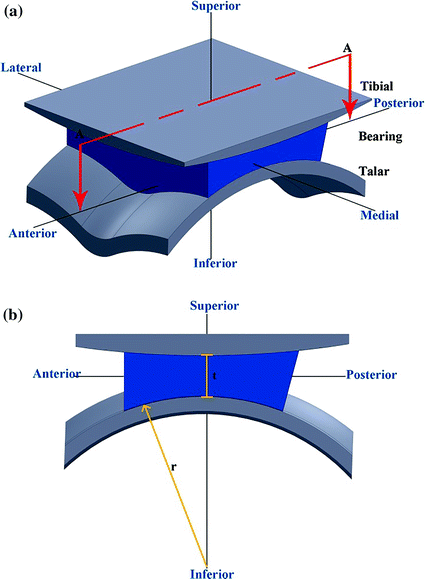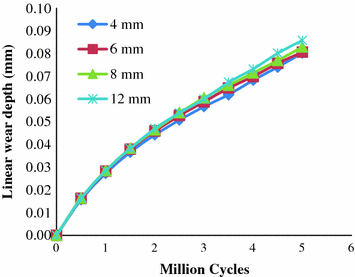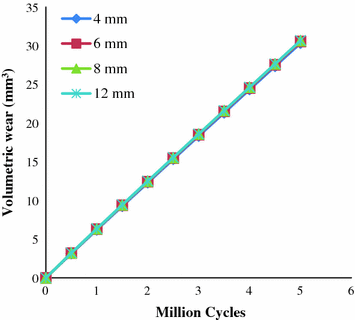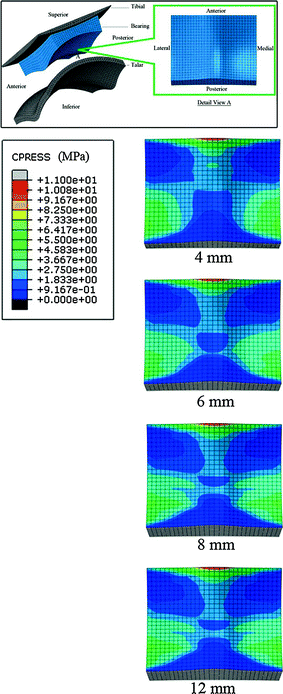, Ardiyansyah Syahrom2 , Muhamad Noor Harun2 and Mohammed Rafiq Abdul Kadir3
(1)
Department of Applied Solid Mechanics and Design, Universiti Teknologi Malaysia, Johor, Malaysia
(2)
Sport Innovation and Technology Centre (SITC), Universiti Teknologi Malaysia, Johor, Malaysia
(3)
Faculty of Biosciences and Medical Engineering, Department of Clinical Sciences, Universiti Teknologi Malaysia, Johor, Malaysia
Abstract
Wear performance was affected by several factors to contribute towards wear generation. Prospect of minimize wear is needed further study by using optimize design parameter. Inevitability to optimize the design is to improve the understanding of reducing wear in human ankle joint. Change in implant dimension has been suggested, may result in better implant lifespan. The effect of design parameter towards wear generation were analysed the thickness and radial contact of meniscal bearing.
Keywords
Wear generationParametric studyDesign parameterThickness of meniscal bearingRadial contact of meniscal bearing4.1 Parametric Study
One of the prospects of contemporary total ankle replacement design is to minimize wear of the bearing component by ensuring the articular surfaces of the entire arc motion to be in perfect congruence to fully conforming three component TAR [1]. Various experimental studies and computational modelling analyses were conducted to optimize design of polyethylene joint particularly to reduce wear [2, 3]. Computational models of wear have been developed to optimize design, materials, patients, and surgical parameters [4]. In this study, the necessity to optimize the design is to improve the understanding of reducing wear in human ankle joint. Therefore, all other analyses were performed based on the geometry mentioned in Sect. 3.2 unless otherwise stated.
4.1.1 Thickness of Meniscal Bearing
The thickness of meniscal bearing varied in 1 mm increment from 5 to 8 mm. The most applicable thickness was chosen to adjust the ligament tension for implantation purposes [5]. It is crucial to study the thickness effect on wear prediction to gain fundamental knowledge. Figure 4.1 shows the thickness of meniscal bearing.


Fig. 4.1
a Three dimensional model and b Section A-A for parameter of the BOX® (Bologna Oxford) TAR
The meniscal bearing thicknesses of 4, 6, 8 and 12 mm were used. The thickness of 6 and 8 mm were the original dimensions produced by the manufacturer. The 4 and 12 mm thicknesses were included in the study because another model of TAR was used [6], even though the value was out of range from the Bologna-Oxford (BOX) manufacturer. The purpose is to develop the correlation between thickness effects towards wear prediction.
The linear wear depths of different thicknesses were evaluated and there were minimal differences between the 4–12 mm thicknesses as shown in Fig. 4.6.
Figure 4.2 shows that the thickness of 4 mm had the least linear wear depth and that the 12 mm thickness has the highest linear wear depth. The thicknesses of 6 and 8 mm have relatively 2 % difference. The thicknesses of 6 and 8 mm were in the range (5–8 mm thickness of meniscal bearing), as was mentioned in Sect. 3.3. Meanwhile, the 4 and 12 mm thicknesses were out of the specified range and the differences were 6 %. Furthermore, the contacted area remained the same at 705 mm2. Figure 4.3 shows that the thickness variations of volumetric wear were identical.



Fig. 4.2
Linear wear depth of different thickness of meniscal bearing

Fig. 4.3
Volumetric wear of different thicknesses of meniscal bearing
Moreover, contour plots of different thicknesses of meniscal bearing of 80 % of the stance phase of the gait cycle (20th instant) are shown in Fig. 4.4. It shows that distributions of contact pressure are relatively similar and that the differences were less than 1 %. Therefore, the different thicknesses of meniscal bearing did not give any significant differences towards wear prediction as it is purposely used to adjust the ligament tension.


Fig. 4.4




Contour plot of contact pressure of different thicknesses of meniscal bearing after 5 million cycles at 80 % of the stance phase of the gait cycle
Stay updated, free articles. Join our Telegram channel

Full access? Get Clinical Tree






